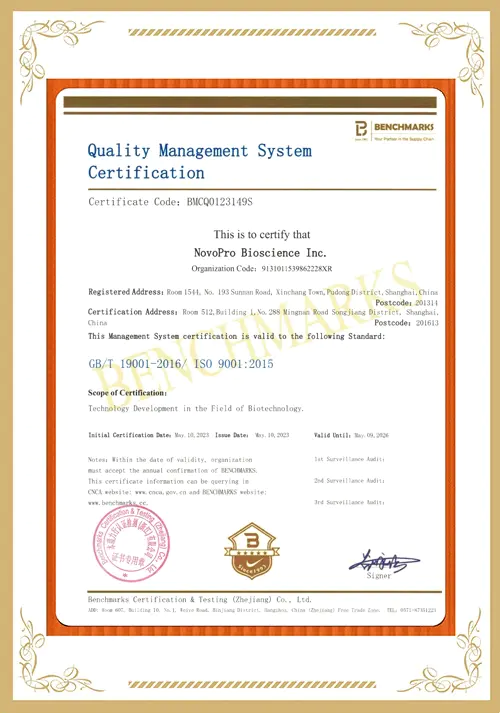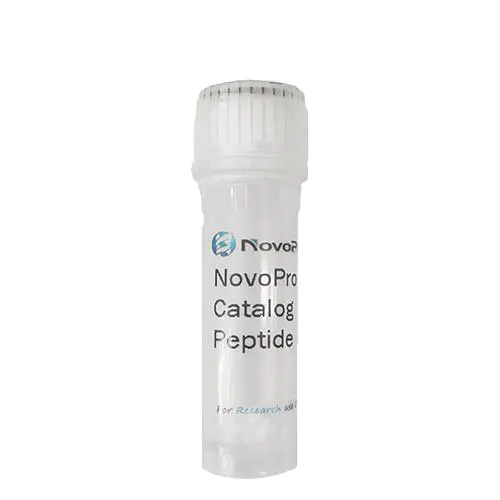Sakacin P peptide
Not For Human Use, Lab Use Only.
Cat.#: 301938
Special Price 799.00 USD
-
Product Name
Sakacin P peptide
-
Documents
Batch to batch variation of the purity
-
Sequence Shortening
KYYGNGVHCGKHSCTVDWGTAIGNIGNNAAANWATGGNAGWNK (Disulfide bridge: Cys9-Cys14)
-
Sequence
H-Lys-Tyr-Tyr-Gly-Asn-Gly-Val-His-Cys-Gly-Lys-His-Ser-Cys-Thr-Val-Asp-Trp-Gly-Thr-Ala-Ile-Gly-Asn-Ile-Gly-Asn-Asn-Ala-Ala-Ala-Asn-Trp-Ala-Thr-Gly-Gly-Asn-Ala-Gly-Trp-Asn-Lys-OH
-
Length (aa)
43
-
Peptide Purity (HPLC)
95.47%
-
Molecular Formula
C192H278N60O59S2
-
Molecular Weight
4434.73
-
Source
Synthetic
-
Form
Powder
-
Description
Sakacin P is a 43-amino acid antimicrobial peptide (AMP) produced by Pediococcus acidilactici and belongs to the class IIa bacteriocins. It exhibits narrow-spectrum antibacterial activity, primarily against Listeria monocytogenes, but shows limited efficacy against gram-negative bacteria. The peptide features an α-helical structure between positions 18–33, which is critical for its antimicrobial function. Studies have demonstrated that modifying this region by substituting specific amino acids with arginine (R) or lysine (K) can enhance its positive charge and amphipathicity, thereby improving antibacterial activity against gram-negative strains like Pseudomonas aeruginosa.
The modified derivatives of Sakacin P, such as Sakacin P16-R8, exhibit increased membrane permeability in bacterial cells, leading to cell death. These peptides demonstrate low cytotoxicity toward eukaryotic cells, maintaining cell viability above 60% even at high concentrations. The antibacterial mechanism involves disrupting bacterial membrane integrity, as evidenced by increased leakage of nucleic acids and proteins, as well as flow cytometry analysis showing significant membrane damage. These properties make Sakacin P and its engineered variants promising candidates for further research in antimicrobial applications.
-
Storage Guidelines
Normally, this peptide will be delivered in lyophilized form and should be stored in a freezer at or below -20 °C. For more details, please refer to the manual: Handling and Storage of Synthetic Peptides
-
References
- Nieto Lozano JC, Meyer JN, Sletten K, Peláz C, Nes IF. Purification and amino acid sequence of a bacteriocin produced by Pediococcus acidilactici. J Gen Microbiol. 1992 Sep;138(9):1985-90.
- Eijsink VG, Brurberg MB, Middelhoven PH, Nes IF. Induction of bacteriocin production in Lactobacillus sake by a secreted peptide. J Bacteriol. 1996 Apr;178(8):2232-7. doi: 10.1128/jb.178.8.2232-2237.1996.
-
About TFA salt
Trifluoroacetic acid (TFA) is a common counterion from the purification process using High-Performance Liquid Chromatography (HPLC). The presence of TFA can affect the peptide's net weight, appearance, and solubility.
Impact on Net Weight: The TFA salt contributes to the total mass of the product. In most cases, the peptide content constitutes >80% of the total weight, with TFA accounting for the remainder.
Solubility: TFA salts generally enhance the solubility of peptides in aqueous solutions.
In Biological Assays: For most standard in vitro assays, the residual TFA levels do not cause interference. However, for highly sensitive cellular or biochemical studies, please be aware of its presence.
-
Molar Concentration Calculator
-
Dilution Calculator
-
Percent Concentration Calculator
Mass (g) = Concentration (mol/L) × Volume (L) × Molecular Weight (g/mol)
Related Products / Services
• Peptide Services: NovoPro's peptide synthesis services include standard chemical peptide synthesis, peptide modification, peptide libraries, and recombinant peptide expression.
• Standard Peptide Synthesis: NovoPro offers quality peptides at the most competitive prices in the industry, starting at $3.20 per amino acid. NovoPro provides PepBox – Automatic Quote Tool for online price calculation.
• Peptide Modifications: NovoPro offers a wide range of peptide modification services including isotope labeling (2H, 15N, and 13C), multiple disulfide bonds, multiple phosphorylations, KLH, BSA, ovalbumin, amidation, acetylation, biotin, FITC, etc.
Please note: All products are "FOR RESEARCH USE ONLY AND ARE NOT INTENDED FOR DIAGNOSTIC OR THERAPEUTIC USE"

